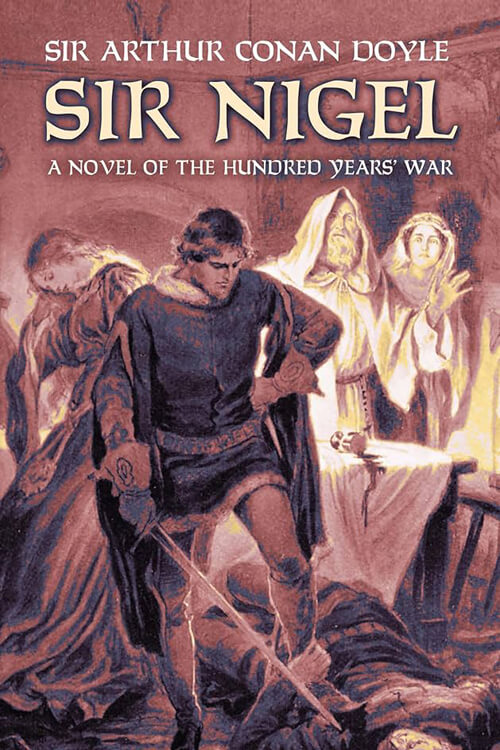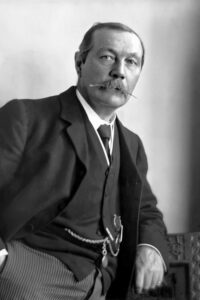
Sir Nigel
In July of the year 1348, between the feasts of St. Benedict and St. Swithin, a strange thing came upon England, for out of the east there drifted a monstrous cloud, purple and piled, heavy with evil, climbing slowly up the hushed heaven. In the shadow of that strange cloud, the leaves drooped in the trees, the birds ceased their calling, and the cattle and the sheep gathered cowering under the hedges. A gloom fell upon all the land, and men stood with their eyes upon the strange cloud and a heaviness upon their hearts. They crept into the churches where the trembling people were blessed and shriven by the trembling priests. Outside no bird flew, and there came no rustling from the woods, nor any of the homely sounds of Nature. All was still, and nothing moved, save only the great cloud which rolled up and onward, with the fold on fold from the black horizon. To the west was the light summer sky, to the east this brooding cloud bank, creeping ever slowly across, until the last thin blue gleam faded away and the whole vast sweep of the heavens was one great leaden arch.
Then the rain began to fall. All day it rained, and all the night and all the week and all the month, until folk had forgotten the blue heavens and the gleam of the sunshine. It was not heavy, but it was steady and cold and unceasing, so that the people were weary of its hissing and its splashing, with the slow drip from the eaves. Always the same thick evil cloud flowed from east to west with the rain beneath it. None could see for more than a bowshot from their dwellings for the drifting veil of the rainstorms. Every morning the folk looked upward for a break, but their eyes rested always upon the same endless cloud, until at last they ceased to look up, and their hearts despaired of ever seeing the change. It was raining at Lammastide at the Feast of the Assumption and still raining at Michaelmas. The crops and the hay, sodden and black, had rotted in the fields, for they were not worth the garnering. The sheep had died, and the calves also, so there was little to kill when Martinmas came and it was time to salt the meat for the winter. They feared a famine, but it was worse than famine which was in store for them.
For the rain had ceased at last, and a sickly autumn sun shone upon a land which was soaked and sodden with water. Wet and rotten leaves reeked and festered under the foul haze that rose from the woods. The fields were spotted with monstrous fungi of a size and color never matched before – scarlet and mauve and liver and black. It was as though the sick earth had burst into foul pustules; mildew and lichen mottled the walls, and with that filthy crop Death sprang also from the water-soaked earth. Men died, and women and children, the baron of the castle, the franklin on the farm, the monk in the abbey, and the villein in his wattle-and-daub cottage. All breathed the same polluted reek and all died the same death of corruption. Of those who were stricken none recovered, and the illness was ever the same – gross boils, raving, and the black blotches which gave its name to the disease. All through the winter the dead rotted by the wayside for want of someone to bury them. In many a village, no single man was left alive. Then at last the spring came with sunshine and health and lightness and laughter – the greenest, sweetest, tenderest spring that England had ever known – but only half of England could know it. The other half had passed away with the great purple cloud.
Yet it was there in that stream of death, in that reek of corruption, that the brighter and freer England was born. There in that dark hour, the first streak of the new dawn was seen. For in no way save by a great upheaval and change could the nation break away from that iron feudal system that held her limbs. But now it was a new country which came out from that year of death. The barons were dead in swaths. No high turret nor cunning moat could keep out that black commoner who struck them down.
Read or download Book
Arthur Conan Doyle
Sir Arthur Ignatius Conan Doyle KStJ, DL (22 May 1859 – 7 July 1930) was a British writer and physician. He created the character Sherlock Holmes in 1887 for A Study in Scarlet, the first of four novels and fifty-six short stories about Holmes and Dr. Watson. The Sherlock Holmes stories are milestones in the field of crime fiction.
Doyle was a prolific writer; other than Holmes’s stories, his works include fantasy and science fiction stories about Professor Challenger, and humorous stories about the Napoleonic soldier Brigadier Gerard, as well as plays, romances, poetry, non-fiction, and historical novels. One of Doyle’s early short stories, “J. Habakuk Jephson’s Statement” (1884), helped to popularise the mystery of the Mary Celeste.
Name
Doyle is often referred to as “Sir Arthur Conan Doyle” or “Conan Doyle”, implying that “Conan” is part of a compound surname rather than a middle name. His baptism entry in the register of St Mary’s Cathedral, Edinburgh, gives “Arthur Ignatius Conan” as his given name and “Doyle” as his surname. It also names Michael Conan as his godfather. The catalogs of the British Library and the Library of Congress treat “Doyle” alone as his surname.
Steven Doyle, publisher of The Baker Street Journal, wrote: “Conan was Arthur’s middle name. Shortly after he graduated from high school he began using Conan as a sort of surname. But technically his last name is simply ‘Doyle’.” When knighted, he was gazetted as Doyle, not under the compound Conan Doyle.
Doyle’s first novels were The Mystery of Cloomber, not published until 1888, and The Unfinished Narrative of John Smith, published only posthumously, in 2011. He amassed a portfolio of short stories, including “The Captain of the Pole-Star” and “J. Habakuk Jephson’s Statement”, both inspired by Doyle’s time at sea. The latter popularised the mystery of the Mary Celeste and added fictional details such as that the ship was found in perfect condition (it had taken on the water by the time it was discovered), and that its boats remained on board (the single boat was missing). These fictional details have come to dominate popular accounts of the incident, and Doyle’s alternative spelling of the ship’s name as the Marie Celeste has become more commonly used than the original spelling.
Between 1888 and 1906, Doyle wrote seven historical novels, which he and many critics regarded as his best work. He also wrote nine other novels, and—later in his career (1912–29)—five narratives (two of novel length) featuring the irascible scientist Professor Challenger. The Challenger stories include his best-known work after the Holmes oeuvre, The Lost World. His historical novels include The White Company and its prequel Sir Nigel, set in the Middle Ages. He was a prolific author of short stories, including two collections set in Napoleonic times and featuring the French character Brigadier Gerard.
Doyle’s works for the stage include Waterloo, which centers on the reminiscences of an English veteran of the Napoleonic Wars and features a character Gregory Brewster, written for Henry Irving; The House of Temperley, the plot of which reflects his abiding interest in boxing; The Speckled Band, adapted from his earlier short story “The Adventure of the Speckled Band”; and an 1893 collaboration with J. M. Barrie on the libretto of Jane Annie.






